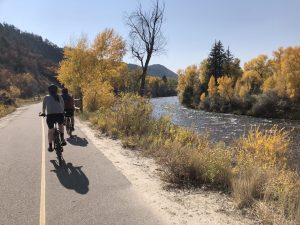Weather
Rocky Mountain Weather – What to Expect

A few words concerning climate in the Rockies during the period from late-Spring through the early-Fall months may be helpful in the selection of the clothing and other gear to bring with you on tour. As a general rule (treat all rules with skepticism), Rocky Mountain summers from June through early October are warm and dry with abundant sunshine and minimal rainfall. Precipitation generally occurs in the form of afternoon showers, which are quite scattered and brief in duration.
This general description of Rocky Mountain climate, however, is only of limited value. Instead, preparation for varying conditions is essential when touring the high country.
Cycling in the Rocky Mountains
The cyclist can generally rely on cool, brilliantly sunny mornings with little wind prior to mid-morning. Afternoons occasionally may bring thundershowers, generally brief in duration. The frequency and severity of these showers increases at higher altitudes (above 10,000 feet). We have planned our days in a manner that will enable us to cycle the higher passes during the morning hours, prior to the buildup of afternoon thunderheads. Though far less frequent and not as intense as those occurring at higher elevations, afternoon showers must be treated at least as a possibility at some point during a tour at lower elevations. The cyclist, therefore, should plan to carry some form of rain jacket or poncho.
Temperatures will range from the mid-40’s to lower-50’s when we begin each morning, increasing to the mid-70’s to mis-80’s by mid-afternoon. Again, elevation can dramatically affect temperature variations. The cyclist should plan to carry a warm shirt or jacket for what can be a chilly descent for the summit of the many passes we will ride. A pair of woolen gloves is also recommended.
No commentary concerning climate is meaningful to the cyclist without some mention of wind. Our touring experience in this area leads us to conclude that any reliance on prevailing wind directions and velocities during the summer and early fall is of little value. Wind direction will vary from day to day, and even in the course of a single day, and we believe that headwinds and tailwinds will balance out by a tour’s end. Should we encounter a headwind, the message is to gear down and don’t permit the wind to “take the day away from you”. Our daily mileages are modest, our pace relaxed and unhurried, and there is no reason to fight the wind to maintain some illusory time schedule.
In summation, although the Rocky Mountain climate from June through early October is generally characterized by warm, dry, sunny days and crisp, cool nights, the cyclist must be prepared for the possibility of afternoon showers and the potential for dramatic temperature variations relative to changes in elevation.






